|
The ruggedness and isolation of the
countryside west of Austin did not deter settlers from
establishing small farmsteads and communities in the
hills during the 1860s and 1870s. Photo by Susan Dial.
|
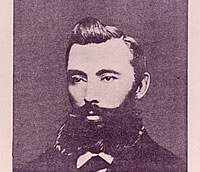
An enterprising clerk and merchant,
Ernst Hallman moved to the hills to raise sheep in the
1880s, despite multiple physical disabilities. Photo
circa 1875, courtesy of the Travis County Bar Association
and Senator Ralph Yarborough.
|

"In small things forgotten…."
An array of objects and mementos left behind in a turn
of the century farmstead range from the mundane—an
orange plastic ice token from a company operating in
Austin in the 1880s—to the more poignant, a brass
bicentennial badge marked with the dates 1776 and 1876.
|
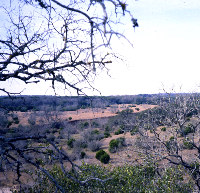
Fertile terraces along creeks provided
deep soil for growing crops on a small scale. The narrow
valleys, bound by limestone bluffs and low hills, provided
a measure of confinement for domestic animals such as
hogs.
|
|
|
The old log house had been well lived in by
more than four generations of families, some of the first
settlers to venture into the hills west of Austin. But after
roughly 100 years of standing up to hard use and the elements,
it had fallen into ruin, its roof caved in, walls sagging,
and floor rotted out. It was a fairly common sight in the
Texas Hill Country, where traces of our pioneer past—fences,
stone walls, houses, and farmsteads—now go largely unnoticed
and, eventually, fall to ruin, the victims of natural processes
or, more commonly now, bulldozers and development.
But this particular house was to be spared,
the landowners intrigued by local stories about its history
and moved by a feeling of responsibility to preserve the heritage
of their land. When they set out to restore it, they did not
merely hire a carpenter but rather a team of specialists to
uncover its history and rebuild it accordingly: archeologists
from the University of Texas at Austin, an architect specializing
in historic structures, even a landscape restorationist. It
was through the efforts of this group that the Doeppenschmidt-Haas
house was brought back to life, the story of a young boy raised
in the house at the turn of the twentieth century was heard,
and the traces of a small pioneer community in the hills west
of Austin were drawn together.
The stories embodied in the now-abandoned farmsteads
and structures are of a people whose everyday lives, by modern
standards, are heroic. The study of these families and the
loosely connected settlement along Barton Creek provides a
record of a little-appreciated time in Texas history. At the
turn of the twentieth century, sweeping changes occurred in
Texas cities with the advent of electricity, communications
systems, and better transportation. In many of the rural areas,
however, time was frozen. Families grew and canned much of
their own food, cooked in fireplaces and wood-burning stoves,
and hauled water for drinking and laundry. Homes were lit
by kerosene and Aladdin lamps. Children attended school periodically,
depending on crop planting and harvest times, and went to
poorly funded institutions referred to as the "mountain
schools."
As a rule, life continued to revolve around
the seasons and the land and the vagaries of nature. Modernization
came relatively late to the hill country, and even then, changes
were gradual. Well into the 1930s and 1940s, some families
continued living what was, in essence, a pioneer existence.
Pieces of the Puzzle
Archeologists from UT Austin survey rocky
hillslopes surrounding a historic site to determine its perimeters
and to recover any artifacts that might help establish its
age.
When archeologists from TARL at UT Austin began
to survey the area, the landowners had already identified
several historic sites. There was the log house that once
belonged to the Haas family and, several miles away, a picturesque
stone building thought by some to have been a country store.
Still more remote was a small cemetery, its few remaining
markers toppled, the walls around the graves reduced, in some
cases, to piles of rubble. There were other historic-era sites
scattered across the property: remnants of stone foundations,
a log crib, a hand-dug well, scatters of purpled glass and
rusted metal. The task at hand was to gather and analyze evidence
from each site, interview neighbors and other informants,
and investigate early records to try to learn more about the
families who once had lived there and who, for the most part,
had vanished.
Bringing the pieces of the puzzle together depended heavily
on deed and court records and recollections of area residents:
When was the area first settled? Who were the settlers and
why did they take on what must have been, at best, a hard-scrabble
existence on the land? Were the families that lived on the
sites related—or were the sites even in use at the same
time? Other information was derived from the physical evidence
itself—the building remains and artifacts left behind
by the former occupants.
Settlement West of Austin
On a larger scale, the hilly area west of Austin
appears to have been settled predominately in the latter quarter
of the nineteenth century, when threats of Indian incursions
had abated. Deed records indicated that although tracts of
land were patented as early as the 1850s, most were left in
a natural state and used as reliable sources of fence posts
and firewood. Within the upper Barton Creek region, archeologists
found that the earliest sites were situated close to a permanent
water supply and fertile valley land. By the turn of the century,
as machine-drilled wells and wire fencing became available,
additional farmsteads were established in upland areas. This
movement also indicated a change in livelihood from small-scale
subsistence farming to larger stock-raising operations requiring
upland grazing areas and more acreage for crops.
One way of understanding a cultural landscape
is through its architectural elements: remnants of physical
structures and fences retain the imprint of the builders and
sometimes can reveal aspects of their origins. In the area
west of Austin, early European American settlers left distinctive
marks on the land. Their diverse cultural backgrounds are
signaled in the fine examples of folk architecture, the varied
complex of stone and log fences, the remains of upland farmsteads,
and the mortuary traditions reflected in the small cemeteries.
In the sections below, we look at several of the more interesting
examples.
|
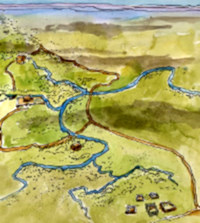
A winding wagon road once connected
family farms in this small Barton Creek community in
the hills west of Austin, circa 1870. Painting by Charles
Shaw.
Click images to enlarge
|
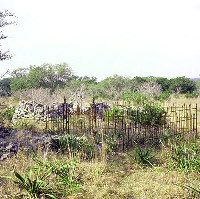
Hillside cemetery—the final
resting place for many of the early settlers.
|
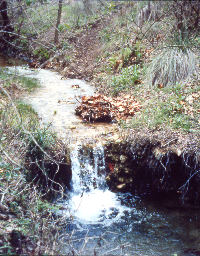
Clear water gushes through the hollows
and creek beds in the limestone hills, fed by underground
springs and periodic rains.
|

TARL archeologists survey along a
road in the project area. Left, Dr. Tom Hester, right,
Paul Maslyck.
|
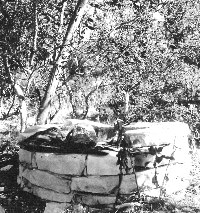
A deep, hand-dug well, lined with
cut limestone, provided water at an upland farmstead
during the early 1900s. It is now the only surviving
structure on that farm. Photo by Susan Dial.
|
|